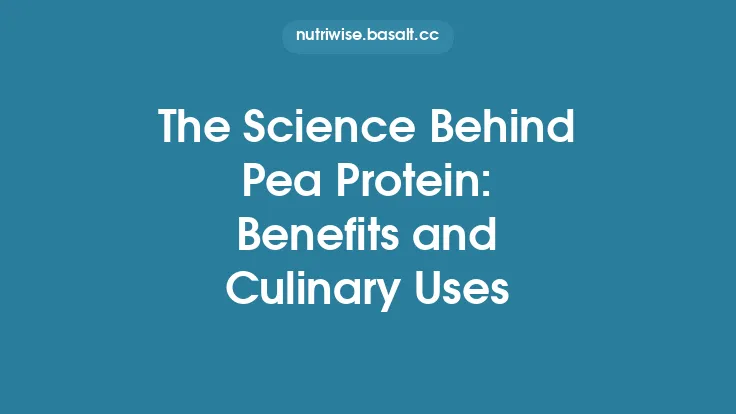Holiday baking is more than a seasonal pastime; it is a convergence of chemistry, culture, and nutrition that has been refined over generations. Families gather around ovens, sharing recipes that have been passed down through stories, celebrations, and rituals. While the aromas of spiced cookies, buttery pies, and caramelized breads evoke nostalgia, the underlying science that makes these treats possible is a fascinating blend of ingredient interactions, thermal dynamics, and nutritional considerations. Understanding this science empowers bakers to honor tradition while subtly enhancing the nutritional profile of their festive creations.
The Chemistry of Holiday Baking
At its core, baking is a series of controlled chemical reactions. When a batter or dough is exposed to heat, several key processes occur:
- Starch Gelatinization – Starches in flour absorb water and swell, forming a gel that provides structure. The temperature at which gelatinization begins (typically 60‑70 °C) determines the crumb texture of cakes and breads.
- Protein Coagulation – Gluten proteins (gliadin and glutenin) and egg proteins denature and form a network that traps gases, giving rise to the rise and elasticity of the final product. The strength of this network is influenced by mixing time, hydration, and the presence of fats.
- Leavening Reactions – Chemical leaveners (baking soda, baking powder) release carbon dioxide through acid‑base reactions, while biological leaveners (yeast) ferment sugars, producing CO₂ and ethanol. The rate and extent of gas production affect volume and crumb structure.
- Maillard Browning and Caramelization – Amino acids react with reducing sugars (Maillard) or sugars decompose (caramelization) at temperatures above 140 °C, creating the golden crust, complex flavors, and aromatic compounds that define holiday treats.
- Fat Melting and Emulsification – Fats melt and coat flour particles, limiting gluten development (shortening effect) and contributing to tenderness. Emulsifiers (e.g., lecithin in eggs) help disperse fat droplets, ensuring uniform texture.
Each of these reactions can be modulated by ingredient selection, mixing methods, and baking parameters, offering opportunities to fine‑tune both sensory qualities and nutritional outcomes.
Nutrient Contributions of Traditional Ingredients
Traditional holiday recipes often rely on a handful of staple ingredients, each bringing distinct macro‑ and micronutrients:
| Ingredient | Primary Nutrients | Functional Role in Baking |
|---|---|---|
| All‑purpose flour | Carbohydrates, small amounts of protein, B‑vitamins (thiamine, niacin) | Provides structure via gluten formation; supplies starch for gelatinization |
| Whole‑grain flours (e.g., whole wheat, rye) | Higher fiber, minerals (iron, magnesium), B‑vitamins | Adds texture, contributes to nutrient density, influences water absorption |
| Butter | Saturated fat, fat‑soluble vitamins (A, D, E, K) | Imparts flavor, creates tender crumb, aids in leavening through steam |
| Eggs | High‑quality protein, choline, lutein, vitamin D | Acts as binder, emulsifier, leavening aid, contributes to color |
| Sugar (granulated, brown, honey) | Simple carbohydrates, trace minerals (in honey) | Provides sweetness, participates in Maillard reactions, influences moisture retention |
| Spices (cinnamon, nutmeg, cloves) | Polyphenols, antioxidants | Contribute aroma, flavor, and modest antioxidant capacity |
| Nuts & dried fruits | Healthy fats, fiber, minerals (potassium, magnesium), vitamins (E, B‑complex) | Add texture, boost nutrient density, contribute to moisture |
By recognizing the nutritional payload of each component, bakers can make informed adjustments that preserve the hallmark qualities of holiday confections.
Balancing Macronutrients in Festive Baked Goods
While the primary goal of a holiday treat is often indulgence, a balanced macronutrient profile can be achieved without sacrificing tradition:
- Carbohydrates – The bulk of a baked good’s mass comes from flour and sugar. Substituting a portion of refined flour with whole‑grain alternatives (e.g., 25 % whole wheat) introduces fiber and micronutrients while maintaining a familiar crumb. Similarly, replacing part of the granulated sugar with naturally sweet, less refined options such as coconut sugar or maple syrup can modestly shift the glycemic impact while preserving sweetness.
- Proteins – Eggs are the main protein source in many recipes. Adding a modest amount of dairy (e.g., Greek yogurt) or plant‑based protein powders (e.g., whey or pea protein) can increase the protein content without dramatically altering texture. The key is to balance the added moisture and adjust leavening accordingly.
- Fats – Butter delivers flavor and tenderness, but incorporating a blend of butter with oils that have a higher proportion of unsaturated fatty acids (e.g., olive oil, avocado oil) can improve the fatty acid profile. A typical ratio of 70 % butter to 30 % oil maintains the characteristic taste while reducing saturated fat content.
By carefully calibrating these macronutrient ratios, bakers can create treats that are both celebratory and nutritionally considerate.
Optimizing Micronutrient Content Without Compromising Flavor
Micronutrients—vitamins and minerals—are often overlooked in festive baking, yet they can be enhanced through strategic ingredient choices:
- Fortified Flours – Many commercial flours are enriched with iron, folic acid, and B‑vitamins. Selecting fortified varieties ensures a baseline micronutrient boost.
- Spice Synergy – Spices such as cinnamon and cloves are rich in polyphenols and have demonstrated antioxidant activity. Using freshly ground spices maximizes these benefits and intensifies aroma.
- Fruit Additions – Incorporating dried fruits (e.g., apricots, figs) or zest (citrus peel) introduces vitamin C, potassium, and flavonoids. Because vitamin C is heat‑sensitive, adding these components toward the end of mixing or as a topping preserves more of the vitamin.
- Nuts and Seeds – Almonds, walnuts, and pumpkin seeds contribute vitamin E, magnesium, and selenium. Toasting them lightly before inclusion enhances flavor while retaining nutrient integrity.
These micronutrient enhancements are subtle enough to blend seamlessly into classic recipes, offering added health value without altering the expected taste profile.
Techniques to Enhance Nutrient Retention During Baking
Heat can degrade certain nutrients, particularly heat‑sensitive vitamins and antioxidants. Applying specific baking techniques can mitigate these losses:
- Temperature Management – Baking at moderate temperatures (e.g., 160‑175 °C) for slightly longer periods can achieve the desired browning while reducing the exposure of delicate nutrients to extreme heat.
- Steam Injection – Introducing steam during the initial baking phase (common in artisan breads) creates a rapid crust formation, limiting moisture loss and preserving water‑soluble vitamins in the interior.
- Layered Baking – For multi‑component desserts (e.g., layered pies), pre‑bake the crust separately and add fruit or nut layers later, minimizing the time heat contacts nutrient‑dense fillings.
- Protective Coatings – Brushing pastries with a thin layer of egg wash or a light glaze can create a barrier that reduces oxidative degradation of surface nutrients.
By integrating these methods, bakers can safeguard the nutritional integrity of their creations while still achieving the coveted holiday aesthetics.
Integrating Whole Grains and Fiber into Classic Recipes
Fiber is a cornerstone of a balanced diet, yet many traditional holiday treats are low in this component. Incorporating whole grains can elevate fiber content without compromising texture:
- Partial Flour Substitution – Replacing 20‑30 % of all‑purpose flour with whole‑grain flour adds soluble and insoluble fiber. To counteract the denser crumb, increase hydration by 5‑10 ml of liquid per 100 g of flour.
- Oat Flour or Bran – Adding oat flour or wheat bran (up to 10 % of total flour weight) imparts a subtle nutty flavor and improves moisture retention, which is beneficial for cookies and quick breads.
- Ancient Grains – Quinoa, amaranth, or spelt flours can be introduced in small quantities (5‑10 %) to provide unique flavors and additional protein, while contributing to the overall fiber pool.
When these adjustments are made thoughtfully, the resulting baked goods retain the familiar mouthfeel and taste that define holiday indulgence.
Smart Use of Fats: From Butter to Healthier Alternatives
Butter’s role in holiday baking is iconic, delivering richness and a distinctive aroma. However, a nuanced approach to fat selection can improve the nutritional profile:
- Butter‑Oil Blends – Combining butter with oils high in monounsaturated fats (e.g., olive oil) reduces saturated fat content while preserving buttery flavor. A 3:1 butter‑to‑oil ratio is a practical starting point.
- Margarine with Minimal Trans Fats – Modern soft margarines formulated without trans fats can serve as a partial butter substitute, especially in recipes where the butter’s flavor is not the dominant element.
- Incorporating Nut Butters – Adding almond or cashew butter (up to 15 % of total fat) introduces healthy unsaturated fats, vitamin E, and a subtle nutty note that complements spices like cinnamon.
- Temperature Control – Keeping fats cold during mixing (e.g., for pie crusts) limits gluten development, resulting in a tender, flaky texture without the need for excessive fat quantities.
These strategies allow bakers to retain the sensory hallmarks of holiday pastries while aligning with contemporary nutritional recommendations.
Flavor Development and Sensory Acceptance
Any nutritional modification must respect the sensory expectations of holiday foods. The science of flavor perception offers guidance:
- Balancing Sweetness and Spice – The interaction between sugars and spices is synergistic; a modest reduction in sugar can be compensated by a slight increase in spice intensity, preserving perceived sweetness.
- Umami Enhancement – Adding a pinch of sea salt or a dash of miso paste (in savory baked goods) can amplify flavor depth, allowing for reduced reliance on fat for richness.
- Aroma Retention – Volatile compounds from spices and extracts are sensitive to prolonged heat. Adding a portion of these aromatics after baking (e.g., a light dusting of cinnamon sugar) can boost flavor perception without altering the baked structure.
- Texture Contrast – Incorporating crunchy elements (toasted nuts, crisped oat clusters) provides sensory variety, which can make a slightly less sweet or less fatty product feel indulgent.
By leveraging these sensory principles, bakers can achieve a harmonious balance between tradition, nutrition, and enjoyment.
Practical Guidelines for Home Bakers
- Start Small – When experimenting with ingredient swaps, modify one component at a time (e.g., replace 10 % of flour with whole‑grain) to assess impact on texture and flavor.
- Measure Precisely – Baking is a scientific process; accurate weighing of ingredients ensures reproducibility, especially when adjusting macronutrient ratios.
- Adjust Hydration – Whole‑grain flours absorb more water. Increase liquid by 5‑10 ml per 100 g of whole‑grain flour to maintain dough consistency.
- Monitor Baking Time – Slightly lower oven temperatures may require a few extra minutes; use visual cues (golden crust, internal temperature) rather than strict timing.
- Taste as You Go – For spice blends and sweeteners, taste the batter or dough before baking to fine‑tune seasoning, keeping in mind that flavors intensify during baking.
- Document Changes – Keep a baking journal noting ingredient ratios, temperatures, and sensory outcomes. This practice facilitates refinement and sharing of successful adaptations.
- Embrace Tradition – Preserve hallmark elements—such as a buttery crust or a specific spice mix—while integrating nutritional enhancements subtly, ensuring the final product feels familiar to family and guests.
Conclusion: Harmonizing Heritage and Health
Holiday baking stands at the intersection of cultural heritage and modern nutritional science. By dissecting the chemical reactions that give rise to beloved textures and flavors, and by recognizing the nutrient contributions of each traditional ingredient, bakers can make informed, incremental adjustments. Whole grains, strategic fat blends, mindful spice utilization, and precise baking techniques collectively enable the creation of festive treats that honor time‑tested recipes while offering enhanced nutritional value.
The essence of holiday baking is not merely the final bite but the shared experience of preparation, storytelling, and communal enjoyment. When the science of baking is applied with respect for tradition, the result is a celebration that nourishes both body and spirit—delivering the warmth of the season in every perfectly balanced morsel.





